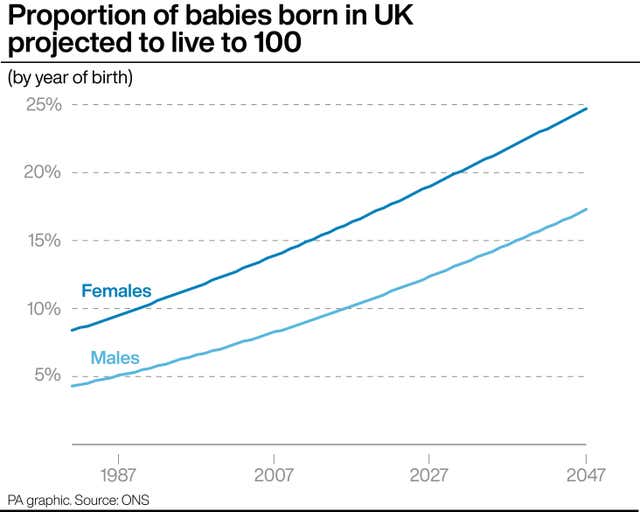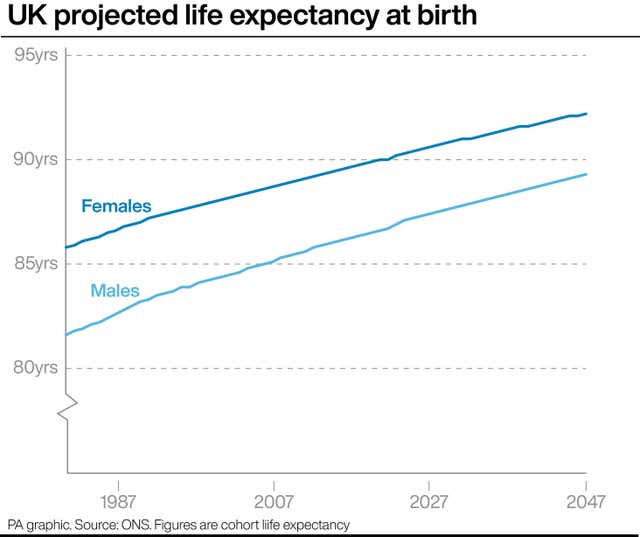One in five girls born in 2030 projected to live to at least 100
The gap between male and female life expectancy at birth has fallen from 4.4 years in 1981 to 3.4 years in 2023.

About one in five girls born in the UK in 2030 is projected to live on average to at least 100 years old, rising to almost one in four by 2047, new figures suggest.
The projections are lower for boys, but still indicate a rise, with more than one in eight males born in 2030 living to celebrate their centenary, climbing to about one in six by 2047.
An improvement in mortality rates among elderly people is one of the key assumptions behind the data, which has been published by the Office for National Statistics (ONS).
The figures are projections, not forecasts or predictions, as they have been modelled on past trends in annual death registrations and combined with the input from a panel of experts.
The projections suggest that 17.9% of girls and 11.5% of boys born in 2023 are expected to live to at least the age of 100, increasing to 19.9% and 13.1% respectively for babies born in 2030.
These proportions then continue to rise, reaching 24.7% and 17.3% for girls and boys born in 2047.

The ONS said it published the data to “allow us to understand the size of the projected population at older ages, which is important for policy making and service planning.”
The figures also project that girls born in the UK in 2023 can expect to live on average to an age of 90.0 years and boys to 86.7 years, increasing to 92.2 years and 89.3 years respectively for babies born in 2047.
Females aged 65 in the UK in 2023 can expect to live a further 22.5 years, while males can expect to live another 19.8 years, projected to rise to 24.4 years and 21.8 years respectively by 2047.
The gap between male and female life expectancy at birth has fallen from 4.4 years in 1981 to 3.4 years in 2023 and is projected to fall further in the future.
All data is based on what is known as cohort life expectancy, which takes into account projected changes in mortality patterns over the lifetime of a group of people with the same year of birth.

The ONS said this is a “more realistic measure” of life expectancy, as it reflects likely improvements in mortality in the future, rather than assuming age-specific mortality rates apply consistently throughout the remainder of a person’s life.
Kerry Gadsdon of the ONS said: “Boys born in the UK in 2023 can expect to live on average to age 86.7 years, and girls to live to 90.0 years, taking into account projected changes in mortality patterns over their lifetime.
“The gap between male and female cohort life expectancy at birth has fallen over the past four decades.
“This is likely due to improvements in lifestyle, for example reduction in smoking rates and the working conditions of men over several decades, as well as advances in healthcare, for example the prevention and treatment of heart disease.
“The gap is projected to be down to 2.5 years by 2072.”
While the proportion of babies projected to live to at least 100 years has “increased significantly over time”, the latest projections are “slightly lower” than previous estimates, the ONS noted.
Figures published in 2022, using 2020-based population data, projected more than a quarter (27.7%) of girls born in 2047 to live until at least 100, along with more than a fifth (21.5%) of boys.
The new projections, using 2022-based population data, revise these downwards to just under a quarter (24.7%) and about a sixth (17.3%).
In addition, the ONS has revised its assumptions about how the UK’s mortality improvement rate will change over time.
Its new projections are based on an annual long-term improvement rate of 1.1% for males and females aged 0 to 90, down from a rate of 1.2% used for the 2020-based projections.
“This reflects that mortality improvements have been consistently slower for more than 10 years and follows advice from our mortality experts about future rates of improvement,” the ONS added.
“However, there is considerable uncertainty about the prospects for mortality improvement rates in the long term and our expert panel noted that these may remain slow at certain ages, or improvements may increase again, through better access to medical advancements or changes to health and social care policy.”





